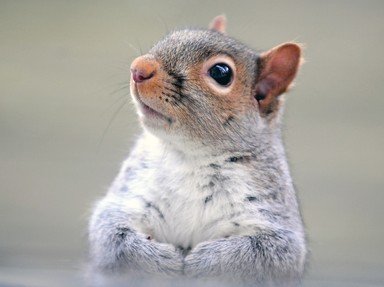Quiz Answer Key and Fun Facts
1. Since Garry is quite sure that groundhogs are living things, the first decision he has to make is which domain they belong to. According to the key he is using, he needs to look at a cell, and see whether or not it has a nucleus. Taking a scraping from inside his sister's mouth and placing it under his microscope, he sees that they all have a dark spot, which is the cell nucleus. Into which of these kingdoms will he be placing groundhogs?
2. Now that he knows what domain he and his family belong to, Garry faces the task of selecting their kingdom. Since he knows how much they love to eat grass (especially alfalfa) and juicy berries as they cavort around the fields during the day, he can answer the next question with confidence, and place them in which kingdom?
3. Garry doesn't need any help in determining that groundhogs are chordates - they belong to the phylum chordate because they have a spinal cord. Since their spinal cord is encased in a protective bony covering made up of bones called vertebrae, he can deduce that they belong in which subphylum?
4. Will these decisions never end? Now Garry has to check out his family's skin covering and reproductive cycle to decide in which class they belong. Ticking hair-covered skin (rather than scales, feathers or smooth skin) and the fact that his younger siblings all suckled milk from their mother for the first five or six weeks of their life, he follows the key to find that they belong in which class?
5. Okay, Garry girds his loins and looks at the next question, which has to do with the babies of his species. After considering his options, he decided that groundhogs are placental. Which of these descriptions of a baby groundhog did he tick?
6. For the next taxonomic level of classification, Garry has to go check his family's teeth. When he discovers that they do indeed all have incisors that grow throughout their lives, he knows that they have to belong to which of these orders?
7. A few levels of classification later, Garry has managed to work his way through the choices to determine that groundhogs belong to the suborder Sciumorpha. Now he needs to decide which family groundhogs belong to. He considers what a typical member of each of these families looks and acts like, and decides that groundhogs belong to which family?
8. Close, but no cigar. Garry the groundhog finds that he still has to make some more decisions to narrow down his family's spot in the tree of life. The next level is called a tribe, and the family with which Garry has identified contains a number of tribes. Which of these is the most appropriate choice?
9. Will this never end? Now poor Garry is faced with selecting a genus for the groundhog. After careful consideration, he decides that it may belong to the genus Marmota. Which of these traits is NOT typical of a marmot?
10. Garry the groundhog takes a deep breath, and prepares for his last decision. Within the genus where he thinks his family belongs, there are a number of species. Considering where he lives, which of the following will he select as the appropriate species?
Source: Author
looney_tunes
This quiz was reviewed by FunTrivia editor
Tizzabelle before going online.
Any errors found in FunTrivia content are routinely corrected through our feedback system.
